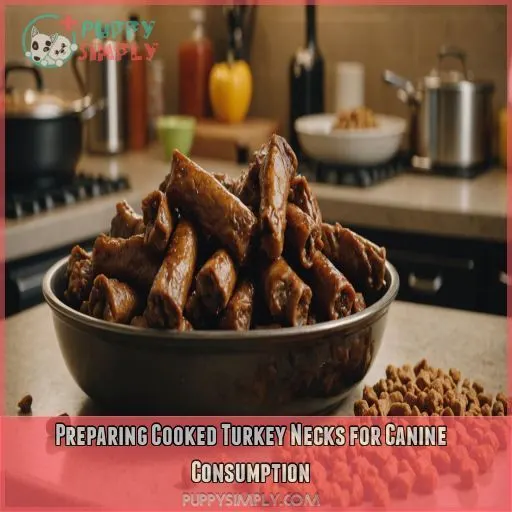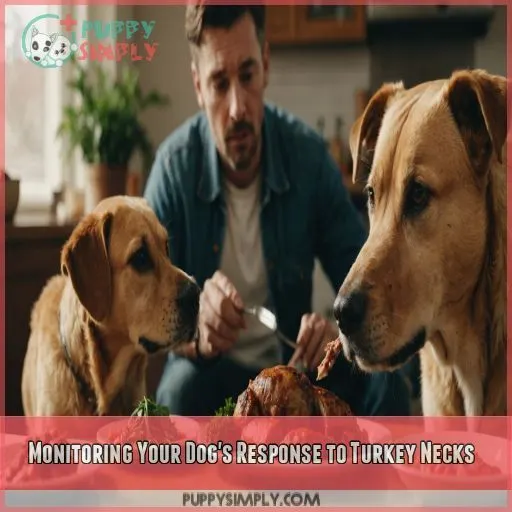This site is supported by our readers. We may earn a commission, at no cost to you, if you purchase through links.

Cooked turkey necks can be a nutritious treat for dogs, packed with protein, glucosamine, and chondroitin for joint health.
However, you must scrap off the meat and avoid serving cooked bones, which can splinter and cause harm. Instead, use the bones to make a bone broth.
As with any new food, introduce cooked turkey necks in moderation and monitor your dog’s response.
Can cooked turkey necks be a healthy addition to your dog’s diet? Let’s explore.
Table Of Contents
- Key Takeaways
- Can Dogs Eat Cooked Turkey Necks?
- Raw Vs. Cooked Turkey Necks for Dogs
- Preparing Cooked Turkey Necks for Canine Consumption
- Health Benefits of Turkey Necks in Dogs’ Diet
- Potential Hazards of Feeding Dogs Cooked Turkey Necks
- Incorporating Turkey Necks Into Your Dog’s Diet
- Selecting High-Quality Turkey Necks for Your Dog
- Monitoring Your Dog’s Response to Turkey Necks
- Alternatives to Cooked Turkey Necks for Dogs
- When to Consult a Vet About Turkey Necks
- Frequently Asked Questions (FAQs)
- Can I cook a turkey neck for my dog?
- Is it better to feed dogs raw or cooked turkey necks?
- Can dogs eat cooked neck bones?
- What is turkey neck syndrome in dogs?
- How long can cooked turkey necks be safely stored?
- Can puppies under 6 months eat cooked turkey necks?
- Do cooked turkey necks cause stomach upset in dogs?
- Can cooked turkey necks be fed to dogs with allergies?
- Are cooked turkey necks suitable for dogs with dental issues?
- Conclusion
Key Takeaways
- You’ll want to introduce cooked turkey necks slowly and in moderation to prevent digestive upset, so be sure to monitor your dog’s response and adjust their serving sizes accordingly. It’s always better to err on the side of caution when introducing new foods, especially if your furry friend has a sensitive stomach.
- When it comes to cooked turkey necks, you’ve got to be mindful of those pesky bones, which can splinter and cause harm. Opt for raw, freeze-dried, or dehydrated turkey necks instead, or remove the meat from cooked necks and use the bones to make a nutritious bone broth.
- Before adding cooked turkey necks to your dog’s diet, you should consult with your vet, especially if your furry friend has pre-existing health conditions, allergies, or dental issues. Your vet can help you weigh the benefits and risks, ensuring your dog’s safety and well-being come first.
- To get the most out of cooked turkey necks for your dog, choose high-quality necks from reputable suppliers, and consider your dog’s age, breed, and size when determining serving sizes. Don’t forget to balance those tasty necks with other nutrient-rich foods to create a well-rounded diet that’ll keep your furry friend happy and healthy.
Can Dogs Eat Cooked Turkey Necks?
You’re wondering if cooked turkey necks are a safe and healthy treat for your furry friend. As a responsible dog owner, it’s great that you’re doing your research, because while cooked turkey necks can be a nutritious addition to your dog’s diet, there are some important benefits and risks to keep in mind.
Benefits of Cooked Turkey Necks for Dogs
Cooking up a storm in the kitchen, you’re wondering if cooked turkey necks are a safe and healthy treat for your furry friend. Here are four benefits to keep in mind:
- protein powerhouse: Cooked turkey necks are an excellent source of protein for muscle growth and repair.
- Joint health: They’re rich in glucosamine and chondroitin, promoting joint health and mobility.
- Dental delight: Turkey necks act as natural dental chews, removing plaque and tartar.
- Nutrient-rich: They contain essential minerals like calcium and phosphorus for overall canine health.
Potential Risks of Feeding Cooked Turkey Necks
As you dish out cooked turkey necks to your furry friend, beware of potential risks lurking beneath the surface. Choking hazards, splintering risks, digestive upset, bacterial contamination, and food safety concerns are all on the table. Here’s a breakdown of the risks to keep in mind:
| Risk | Description | Prevention Tips |
|---|---|---|
| Choking hazards | Cooked bones can splinter and get stuck | Supervise mealtime, chop necks into smaller pieces |
| Splintering risks | Sharp edges can cause internal damage | Choose raw or dehydrated necks instead |
| Digestive upset | Cooked bones can be difficult to digest | Introduce necks slowly, monitor stool quality |
| Bacterial contamination | Undercooked necks can harbor bacteria | Cook necks thoroughly, handle safely |
| Food safety concerns | Improper storage can lead to spoilage | Store necks safely, check expiration dates |
Nutritional Value of Cooked Turkey Necks
Now that we’ve explored the potential risks, let’s get to the good stuff!
Cooked turkey necks are a nutrient-rich treat for your furry friend.
They’re packed with protein, glucosamine, and chondroitin for joint support, as well as calcium and phosphorus for healthy bones.
They even provide dental benefits by helping remove plaque and tartar.
A win-win for your dog’s overall health!
Recommended Serving Sizes for Different Dog Breeds
For serving cooked turkey necks, size matters. For small breeds (under 20 pounds), start with a quarter to half a neck, while larger breeds (over 50 pounds) can handle a whole neck. Consider your dog’s age, weight, and breed-specific needs when determining serving sizes. Always err on the side of caution to avoid overfeeding or choking hazards.
Raw Vs. Cooked Turkey Necks for Dogs
So, you’ve learned that dogs can eat cooked turkey necks, but is it better to serve them raw? Let’s explore the pros and cons of each option.
Raw turkey necks offer a range of benefits for your dog’s health. They’re a good source of protein, essential for muscle development and repair. They also contain calcium, phosphorus, and other minerals that support bone and teeth health. Additionally, raw turkey necks are rich in glucosamine and chondroitin, which promote joint health and mobility. These necks are softer and less likely to splinter, making them safer for your dog to chew on.
However, raw meat and bones may be contaminated with harmful bacteria such as Salmonella and E. coli, which can cause food poisoning in dogs, especially those with underlying health issues. This is a risk to keep in mind, especially if you have children or immunocompromised family members.
Cooked turkey necks should be approached with caution. Cooking the necks can make the bones brittle, increasing the risk of splintering, which can cause internal injuries to your dog. However, cooking eliminates potential health hazards like bacterial contamination.
Dehydrated turkey necks are another option, but they’re typically higher in calories than fresh turkey necks. They also carry the risk of bacterial contamination and should be avoided if they’ve been dried at high temperatures, as this makes the bones more brittle.
When deciding between raw and cooked turkey necks, it’s important to weigh the benefits and risks of each. Raw necks offer superior nutritional value and are safer due to their softer texture, but they carry a risk of bacterial contamination. Cooked necks reduce the risk of bacteria but are more likely to splinter and cause internal injuries. Dehydrated necks are a convenient option but be mindful of their calorie content and processing method. Always supervise your dog while they enjoy this treat, and remember to consult your veterinarian for personalized advice.
Preparing Cooked Turkey Necks for Canine Consumption
Now that you’ve decided to feed your furry friend cooked turkey necks, it’s time to prep and serve them safely. Let’s get into the nitty-gritty of preparing these meaty treats, ensuring they’re safe, tasty, and nutritious for your four-legged companion.
Proper Cleaning and Washing Techniques
Before cooking turkey necks for your furry friend, give them a good rinse under cool running water to remove any debris or bacteria. You want to make sure those necks are squeaky clean to keep your dog safe. Sanitation is key for dog treats, so take a minute to scrub those turkey neck bones clean.
Cooking Methods: Boiling, Grilling, and Baking
Now that you’ve properly cleaned those turkey necks, it’s time to cook them up for your furry friend.
For boiling, grilling, or baking, the key is temperature control and cooking time.
Boiling is a great way to retain moisture, while grilling adds a smoky flavor.
Baking is also a safe bet, as long as you keep an eye on that bone texture.
Cooling and Serving Recommendations
Now that you’ve boiled, grilled, or baked those turkey necks, it’s time to let them cool down completely.
You want them to be room temperature or slightly warm, not hot or cold.
This will help prevent burns or discomfort for your furry friend.
Serve them up, and make sure your dog has access to fresh water – especially when enjoying dehydrated treats!
Portioning and Storage Guidelines
You want to make sure your furry friend gets the right amount of cooked turkey neck, right? Here are some things to keep in mind:
- Choose the right turkey neck size for your dog’s breed and age.
- Store cooked turkey necks in the freezer for up to 3 months.
- Always thaw frozen turkey necks in the fridge or cold water.
- Portion cooked turkey necks 2-3 times a week.
- Mix with dog food recipes for a balanced diet and to reap turkey neck benefits for pet health.
Health Benefits of Turkey Necks in Dogs’ Diet
As you consider adding turkey necks to your dog’s diet, you’ll be pleased to know that they offer a wealth of health benefits that can support your furry friend’s overall well-being. From high-quality protein for muscle health to glucosamine and chondroitin for joint support, turkey necks are a nutritious treat that can make a real difference in your dog’s life.
High-Quality Protein Source for Muscle Health
The pursuit of puppy perfection! As a dog parent, you want to fuel your furry friend’s growth and strength. Cooked turkey necks are a high-quality protein source that can help meet your dog’s protein needs, especially during growth stages. Rich in lean protein, they support muscle building and dog strength, making them a great alternative to commercial dog treats.
Glucosamine and Chondroitin for Joint Support
In the matter of joint health, turkey necks are a powerhouse! Rich in glucosamine and chondroitin, they provide natural relief for canine arthritis. These anti-inflammatory compounds help maintain joint mobility and reduce pain. Plus, they’re a tasty alternative to supplements. So, ditch the pills and offer your furry friend a dehydrated turkey neck instead – their joints will thank you!
Dental Health Advantages of Chewing Turkey Necks
Now that we’ve covered how turkey necks can support your dog’s joint health, let’s talk about the dental benefits. Chewing on turkey necks can be a game-changer for your dog’s oral health. Here are four reasons why:
- Tartar removal: Turkey necks help scrape off tartar, promoting healthy gums.
- Canine plaque control: Regular chewing prevents plaque buildup.
- Fresh breath maintenance: A healthy mouth means fresher breath.
- Natural dental care: Turkey necks are a great alternative to toothbrushes.
Essential Minerals: Calcium and Phosphorus Content
When giving your dog a turkey neck to chew on, you’re providing them with a boost of calcium and phosphorus.
These two minerals are necessary for healthy bones.
A balanced ratio of these minerals is key to preventing deficiencies or overloads, which can lead to bone diseases.
To ensure your dog is getting the right nutrients, choose high-quality turkey necks with the correct nutrient ratio.
Potential Hazards of Feeding Dogs Cooked Turkey Necks
When you’re considering adding cooked turkey necks to your dog’s diet, you need to be aware of the potential hazards that come with them. From choking risks to bacterial contamination, understanding these risks will help you make an informed decision and keep your furry friend safe and healthy.
Choking Risks and Prevention Measures
When giving your dog cooked turkey necks, choking hazards are a top concern. To minimize risks, chop the necks into manageable pieces or use a slow-feeder bowl. Supervise mealtime, and have a plan in place in case of an emergency. Be aware of bone splinter dangers, and take steps to choke-proof your dog’s snacking routine.
Digestive Blockage Concerns
Now that we’ve covered choking risks, let’s talk about another hazard: digestive blockage concerns. If your dog swallows a large piece of turkey neck, it can get stuck in their intestines, causing a gastrointestinal blockage. Watch for signs like vomiting, diarrhea, or lethargy. To avoid this, make sure to chop the neck into manageable pieces or supervise mealtime closely.
Bacterial Contamination and Food Safety
When handling raw turkey necks, you’re dealing with raw meat, a breeding ground for bacteria like Salmonella and E. coli.
To minimize the risk, follow safe storage tips. Keep them refrigerated at 40F (4C) or below. Wash your hands thoroughly after handling.
Reducing bacteria risk is key to preventing foodborne illness in both you and your furry friend.
Splintering Risks of Cooked Bones
Now that we’ve tackled bacterial contamination, let’s talk about another risk: splintering. Cooked bones can become brittle and prone to fragmentation, posing a serious threat to your dog’s safety. A splintered bone can cause internal damage or even puncture essential organs. To avoid this, opt for raw or dehydrated turkey necks, which are less likely to splinter.
Incorporating Turkey Necks Into Your Dog’s Diet
As you consider adding turkey necks to your dog’s diet, a key consideration is striking a balance between treating your furry friend and ensuring their overall nutrition remains well-rounded. By incorporating turkey necks thoughtfully, you can provide a tasty and healthy addition to their meals without overdoing it.
Frequency of Feeding Turkey Necks
Now that we’ve covered the potential hazards of feeding dogs cooked turkey necks, let’s talk about how often to give them to your furry friend. In terms of frequency, it’s all about balance.
- Offer a half to one turkey neck two to three times a week.
- Consider your dog’s age, size, and breed when determining portion sizes.
- Rotate turkey necks with other healthy treats to avoid overfeeding.
- Always supervise meal times to prevent choking hazards.
Mixing Turkey Necks With Regular Dog Food
As you mix turkey necks with regular dog food, remember to balance the nutrients. A general rule of thumb is to replace 10-20% of their meal with turkey necks. Here’s a rough guide to get you started:
| Dog Size | Turkey Neck Ratio |
|---|---|
| Small | 1/4 neck per 1 cup food |
| Medium | 1/2 neck per 1.5 cups food |
| Large | 3/4 neck per 2 cups food |
| Extra Large | 1 neck per 2.5 cups food |
| Giant | 1.25 necks per 3 cups food |
Turkey Necks as Occasional Treats
When using turkey necks as occasional treats, follow treat frequency guidelines to avoid overfeeding. Consider your dog’s size, nutrient balance, and potential allergies. For medium to large dogs, offer a half to one turkey neck two to three times a week. Always supervise safe chewing practices to prevent choking hazards and make sure your pup stays happy and healthy.
Balancing Turkey Necks With Other Protein Sources
- Mix turkey necks with kibble for a varied diet
- Rotate protein sources to avoid food allergies
- Balance treats with regular meals
- Don’t overdo it – treats should be 10% of their diet
- Consider your dog’s age, breed, and health when choosing protein sources
Selecting High-Quality Turkey Necks for Your Dog
As you consider adding turkey necks to your dog’s diet, it’s important to prioritize quality to make sure your furry friend reaps the benefits while minimizing the risks. By choosing high-quality turkey necks from reputable suppliers and being mindful of ingredients and processing methods, you can provide your dog with a nutritious and safe treat.
Sourcing From Reputable Suppliers
When sourcing turkey necks, you want to go straight to the good stuff – reputable suppliers who prioritize quality and ethics. Look for local suppliers or online retailers with quality assurance certifications, such as USDA or third-party audits. These certifications guarantee the turkey necks meet rigorous standards, giving you peace of mind and a healthy pup.
Avoiding Preservatives and Added Seasonings
When selecting high-quality turkey necks, you want to avoid preservatives and added seasonings like the plague. These extras can be detrimental to your dog’s health. Here are three things to watch out for:
- Artificial preservatives like sodium nitrite or sodium nitrate
- Seasonings like onion powder, garlic powder, or paprika
- Fillers like corn, wheat, or soy that can trigger allergies
Organic Vs. Conventional Turkey Neck Options
When choosing between organic and conventional turkey necks, consider your priorities. Organic options meet stricter standards for animal welfare and environmental sustainability, but come with a higher price tag. Conventional turkey necks are more budget-friendly, but may raise concerns about sourcing and environmental impact.
| Option | Price | Sourcing |
|---|---|---|
| Organic | $5-$7 | Stricter animal welfare, sustainable farming |
| Conventional | $3-$5 | May involve factory farming, more environmental impact |
| Local Farm | $4-$6 | Supports local economy, variable sourcing standards |
| Specialty Pet Store | $6-$8 | May prioritize animal welfare, varied sourcing |
Freeze-Dried and Dehydrated Turkey Neck Alternatives
When picking high-quality turkey necks for your dog, you have more options than just organic vs. conventional. Let’s consider freeze-dried and dehydrated turkey neck alternatives – a great choice for pet owners who want to minimize processing and preserve nutrients. Here are some things to keep in mind:
- Lower risk of bacterial contamination
- Retains more nutrients than cooking
- Can be more expensive than raw or cooked necks
- Still a choking hazard if not sized correctly
- May require rehydration before serving
Monitoring Your Dog’s Response to Turkey Necks
As you introduce turkey necks into your dog’s diet, you should closely monitor their response to make sure they’re reaping the benefits without any adverse effects. By keeping a watchful eye on your dog’s behavior, digestive health, and overall well-being, you can adjust their turkey neck consumption to optimize the rewards and minimize the risks.
Signs of Allergic Reactions or Sensitivities
Now that you’ve selected high-quality turkey necks, it’s time to monitor your dog’s response. Keep an eye out for signs of allergic reactions or sensitivities, such as excessive itchiness, skin rashes, or sneezing. If your dog experiences vomiting or diarrhea after eating turkey necks, consult your vet immediately. Your dog’s health is worth the caution!
Digestive Changes to Watch For
As you introduce turkey necks into your dog’s diet, keep an eye out for digestive changes. Watch for diarrhea, vomiting, or gas, which could indicate an adverse reaction. Monitor your dog’s appetite and stool consistency, too. If you notice any unusual changes, consult your vet for guidance. Your furry friend’s comfort and safety are top priority!
Positive Effects on Coat and Skin Health
As you monitor your dog’s response to turkey necks, keep an eye out for a shinier coat and healthier skin.
The omega-3 fatty acids and biotin in turkey necks can work wonders!
If you’re already giving your dog salmon oil supplements, you might notice an extra glow.
A healthy coat and skin are just a few perks of adding turkey necks to their diet.
Improvements in Joint Mobility and Energy Levels
- Increased playtime: Is your dog initiating play or seeming more enthusiastic about exercise?
- Easier movement: Are they jumping, running, or climbing stairs with more ease?
- Reduced stiffness: Do they seem more limber after rest or exercise?
Alternatives to Cooked Turkey Necks for Dogs
While cooked turkey necks can be a tasty treat for your dog, you might be wondering about other options.
Whether you’re seeking alternatives due to health concerns, availability, or simply wanting to mix things up, we’ve got you covered.
From other poultry parts to commercial dental chews, let’s explore some safe and nutritious substitutes that your furry friend is sure to enjoy.
Other Poultry Parts: Feet, Wings, and Gizzards
As you explore alternatives to cooked turkey necks, consider other poultry parts like feet, wings, and gizzards. These can provide similar nutritional benefits and dental advantages. However, it’s important to make sure they’re sourced from reputable suppliers and cooked safely to avoid bacterial contamination. Always consult with your vet before introducing new foods or chews to your dog’s diet.
Commercial Dental Chews and Their Effectiveness
Now that you’ve considered other poultry parts, let’s chew on this: commercial dental chews can be a convenient alternative to cooked turkey necks. When choosing a brand, consider:
- Chew texture: is it gentle on teeth and gums?
- Ingredient quality: are they using wholesome ingredients?
- Dental benefits: do they reduce tartar and plaque?
- Brand comparison: which ones have the best reviews?
- Long-term effects: are they safe for regular consumption?
Vegetable-Based Chews for Dogs With Poultry Allergies
If your furry friend has a poultry allergy, don’t worry, there are veggie-based chews to the rescue! Brands like Sweet Potato Chews or Carrot Dental Chews offer tasty, allergy-friendly alternatives. These chews satisfy your dog’s urge to chew and promote healthy teeth and gums, all while avoiding poultry-based ingredients that might trigger allergic reactions.
Synthetic Bones and Their Safety Profiles
Considering vegetable-based chews mightn’t be your dog’s cup of tea, let’s explore synthetic bones as an alternative. When choosing synthetic bones, prioritize biocompatibility and durability. Look for products made from non-toxic materials that can withstand aggressive chewing. While they may seem like a safe bet, it’s important to monitor your dog’s behavior and watch for signs of adverse reactions.
When to Consult a Vet About Turkey Necks
Before sharing those tasty turkey necks with your furry friend, it’s really important to consult with your veterinarian, especially if your dog has pre-existing health conditions or specific dietary needs. Your vet can help you determine the best approach for introducing turkey necks into your dog’s diet, taking into account their age, breed, dental health, and overall nutritional balance.
Pre-existing Health Conditions and Dietary Restrictions
If your furry friend has pre-existing health conditions like kidney disease, diabetes, or allergies, it’s vital to consult your vet before introducing cooked turkey necks into their diet. Even obesity or pancreatitis require special consideration. Your vet will help you weigh the benefits and risks, ensuring your dog’s safety and well-being come first. Better safe than sorry!
Age and Breed-Specific Considerations
When introducing turkey necks to your dog’s diet, consider their life stage. As your furry friend grows, their needs change. Here are a few things to keep in mind:
- 1. Puppies under 6 months: Avoid giving them turkey necks to prevent choking hazards.
- 2. Senior dogs: Choose softer, easier-to-chew options.
- 3. Small breeds: Opt for smaller, more manageable pieces.
- 4. Large breeds: Supervise closely to prevent overconsumption.
Dental Health Assessments Before Introducing Chews
Before giving your dog cooked turkey necks, get their teeth checked! Schedule an oral exam with your vet to verify their gums and teeth are healthy enough for chewing. Here’s what to expect:
| Oral Exam Essentials | What to Look For |
|---|---|
| Dental X-ray Safety | Signs of tooth decay or cracks |
| Canine Gum Care | Redness, swelling, or bleeding |
| Tartar Control Methods | Excessive tartar buildup |
| Plaque Removal Tips | Plaque accumulation, bad breath |
Your vet will help determine if cooked turkey necks are a safe and healthy treat for your furry friend.
Nutritional Counseling for Balanced Diets With Turkey Necks
Now that you’ve considered dental health assessments, let’s talk about nutritional counseling for balanced diets with turkey necks. When adding turkey necks to your dog’s diet, it’s necessary to guarantee they’re part of a well-rounded meal plan. Here are 4 things to discuss with your vet:
- Canine Nutrition Planning: Creating a customized diet that meets your dog’s unique needs.
- Balanced Meal Strategies: Mixing turkey necks with other protein sources and veggies for a balanced diet.
- Pet Food Guidelines: Understanding what to look for in commercial dog food to avoid allergies and sensitivities.
- Diet Changeover Tips: Gradually introducing turkey necks to prevent digestive upset.
Frequently Asked Questions (FAQs)
Can I cook a turkey neck for my dog?
Did you know 76% of dogs in the US suffer from dental disease? You can cook a turkey neck for your dog, but be cautious: cooked bones can splinter, so you need to choose the right cooking method and supervise their chewing.
Is it better to feed dogs raw or cooked turkey necks?
If you’re thinking about giving your dog turkey necks, you’re likely wondering whether to go raw or cooked. Honestly, raw, freeze-dried, or dehydrated turkey necks are safer for dogs, as cooked bones can become brittle and splinter.
Can dogs eat cooked neck bones?
Imagine being a master chef for your furry friend, but regarding cooked neck bones, it’s best to exercise caution. While cooked turkey is fine, cooked bones can become brittle and splinter, posing a hazard.
What is turkey neck syndrome in dogs?
Turkey neck syndrome in dogs refers to sagging skin under a dog’s neck, often seen in older or overweight dogs. It can also be caused by an allergic reaction to a bee sting.
How long can cooked turkey necks be safely stored?
You’ve cooked those turkey necks, now store them safely! Cooked turkey necks can be refrigerated for 3-4 days or frozen for up to 2 months. Always check for spoilage before serving to your furry friend.
Can puppies under 6 months eat cooked turkey necks?
You’re wondering if puppies under 6 months can eat cooked turkey necks safely. It’s generally not recommended , as their teeth and digestive system are still developing, and bones can pose a choking hazard or cause internal blockages .
Do cooked turkey necks cause stomach upset in dogs?
Blimey, mate! Cooked turkey necks can be a recipe for stomach upset in dogs if not done right. Introduce them slowly, in moderation, and under supervision to avoid digestive woes, and always consult your vet, just in case!
Can cooked turkey necks be fed to dogs with allergies?
If your dog has allergies, consult with your vet before feeding cooked turkey necks. While they’re a nutritious treat, allergies can be unpredictable, and it’s really important to prioritize your furry friend’s safety and comfort.
Are cooked turkey necks suitable for dogs with dental issues?
If your dog has dental issues, cooked turkey necks can be a great addition to their oral care routine, helping remove plaque and tartar. However, always consult with your vet to determine the best approach for your furry friend.
Conclusion
Cooked turkey necks can be a delightful treat for your canine companion, but tread carefully.
Like a tightrope walker, you must balance the nutritional benefits with the potential risks.
Introduce them slowly, monitor your pup’s response, and consult your vet if any concerns arise.
With the right approach, can dogs eat cooked turkey necks? Absolutely – just be mindful every step of the way.















